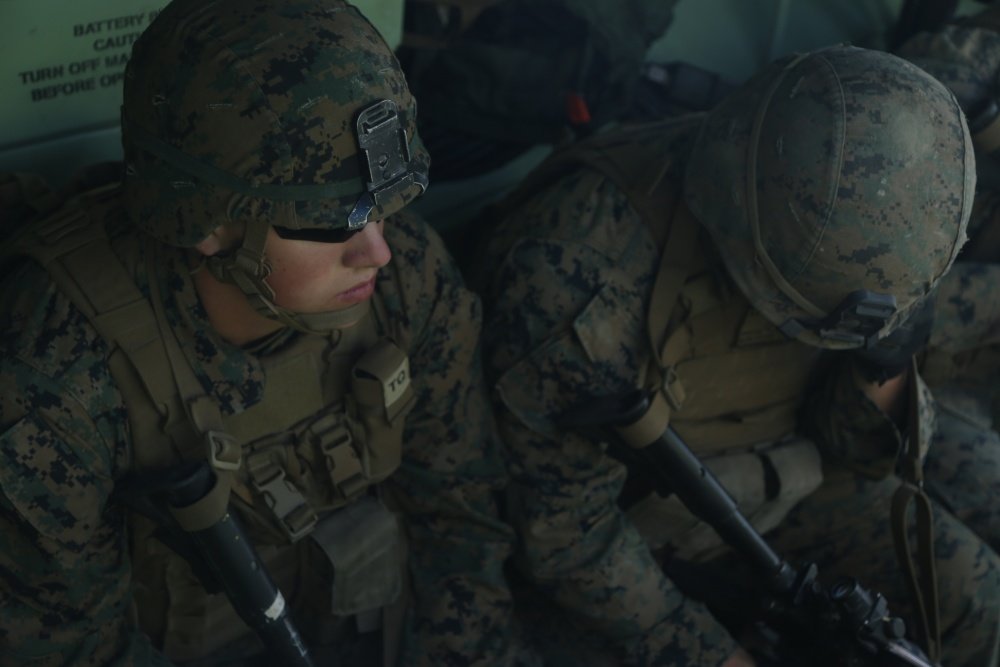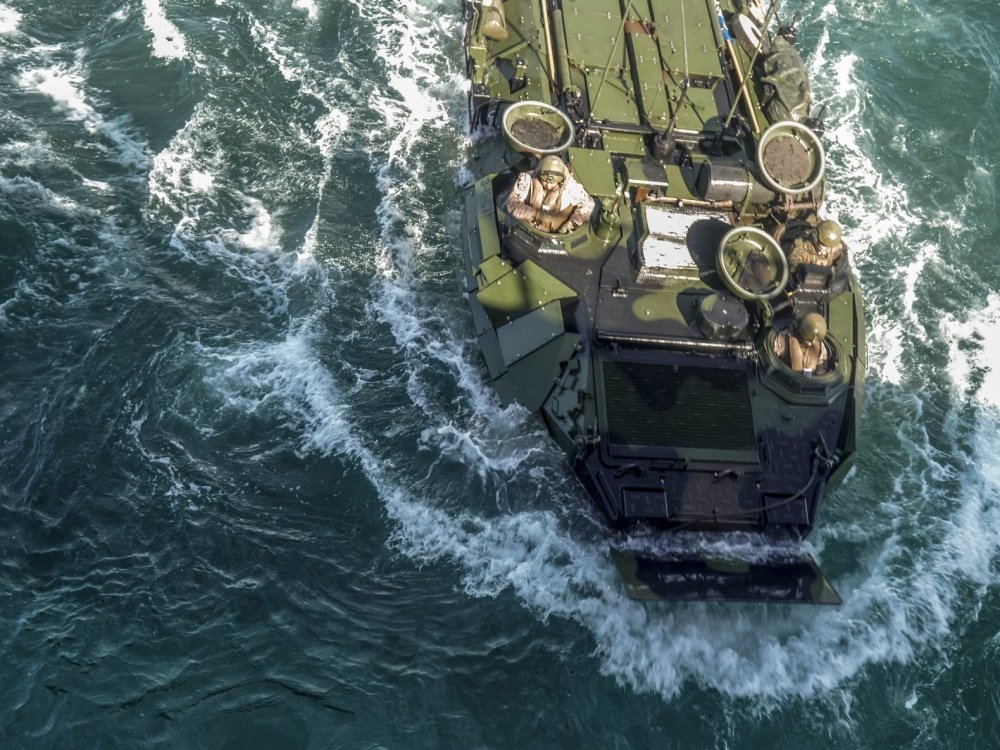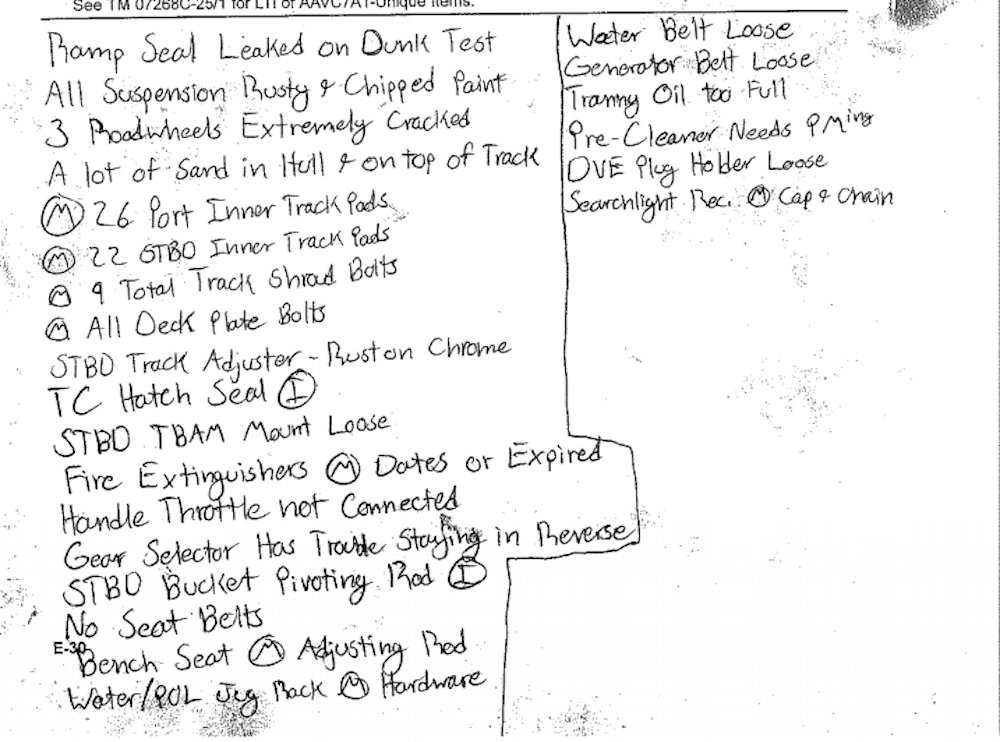Marine Trackers Push Back After General Blames Vehicle Commander for Deadly AAV Mishap

US Marines with 3rd Assault Amphibian Battalion, 1st Marine Division, drive an assault amphibious vehicle during a splash and recovery drill from the San Antonio-class amphibious transport dock ship, USS Portland, as part of Exercise Iron Fist 2020, off the coast of Marine Corps Base Camp Pendleton, Calif., Feb. 6, 2020. US Marine Corps photo by Cpl. Anabel Rodriguez, courtesy of DVIDS.
On Friday, the Marine Corps released its investigative report into the July 30, 2020, sinking of an Assault Amphibious Vehicle, or AAV, off the coast of California — a mishap that left eight Marines and one Navy sailor dead. According to Lt. Gen. Karsten Heckl, commanding general of 1st Marine Expeditionary Force, the AAV’s vehicle commander was to blame.
“The vehicle commander’s failure to evacuate personnel at the appropriate time was the ultimate tragic failure which resulted in the loss of life and injury,” Heckl wrote.
Coffee or Die Magazine spoke with three Marines who served aboard AAVs, including Michael Manson, who was a platoon commander in an Assault Amphibian Battalion and left the Marines in 2013. Two active-duty Marines, both of whom served as AAV vehicle commanders, spoke on condition of anonymity due to professional restrictions on communicating with members of the media.
Altogether, the three Marines described an operational culture in which Marines know the equipment they use is both aging and dangerous, yet they continue to execute the mission — because that’s what Marines do.

Vehicle Commander Pinned With Blame
“Ultimately, this entire mishap could have been averted and lives saved if the vehicle commander had followed [standard operating procedures] and ordered the embarked personnel to take off their gear and evacuate the mishap AAV,” Heckl wrote in the accident report.
“I don’t agree with that at all, it’s really a culture thing that the track is going to have water in it, and it doesn’t matter,” an active-duty Marine who served aboard AAVs from 2008 to 2013 and was a vehicle commander told Coffee or Die. “From the beginning when you’re at the ‘schoolhouse’ it’s engrained in your head that the track is going to take on water, that it’s not a big deal.”
“The community is built on: The vehicles suck, the parts suck, we do more with less. It’s almost like a weird point of pride — the vehicles suck, they’re always broken,” added the Marine, who has since transferred to another occupational specialty.
The Marine Corps did not respond to multiple requests for comment.
The AAV is the Marine Corps’ workhorse amphibious landing vehicle, designed to transport at least a dozen Marines onto shorelines and support them onward to inland objectives. Known among Marines as an “amtrac,” for amphibious tractor, the AAV is a tracked vehicle that operates both as a boat and as a ground vehicle. Unlike landing vessels used in World War II, the AAV transports landing Marines through the deadly surf zone and allows them to disembark farther inland.
The Marine Corps’ AAV fleet has been in continuous operation since it entered service in 1972, making it one of the oldest troop-carrying vehicles in the US military. While AAVs are designed for amphibious assaults, they have seen extensive use during post-9/11 counterinsurgency campaigns, including the 2003 invasion of Iraq, as an armored personnel carrier.

Some military personnel have said the AAV lacks sufficient protective armor for an exclusively ground-combat role. During the battle of Nasiriyah, Iraq, in 2003, eight AAVs were either disabled or destroyed by enemy fire during an engagement, which left 18 Marines dead. On Aug. 3, 2005, 14 Marines were killed in an AAV outside of Haditha, Iraq, when an improvised explosive device detonated underneath the vehicle — an unarmored location on the vehicle.
The Marine Corps report into the July 2020 AAV accident reveals how the vehicle suffered a number of recurrent technical issues. It also describes a vehicle commander, or VC, attempting to do everything possible to save his craft, crew, and passengers. Yet, the vehicle commander’s desperate actions were subsequently criticized because they deviated from standard procedures.
“The whole organization should have been a backstop from a maintenance standpoint. It’s not just on the vehicle commander. There are responsibilities which go higher,” Manson, who served as a platoon commander from 2010 to 2013 in an Assault Amphibian Battalion, said.
During the 2020 mishap, the AAV began to take on water, causing the radios to fail, along with the electrical system. These mechanical failures prevented the craft from effectively pumping out the seawater that was infiltrating through damaged watertight seals.
At this point, the report describes the VC as climbing onto the roof, in worsening maritime conditions, and waving the “November flag” as a distress signal. This action is only done when primary means of communication fail, according to Marine Corps personnel.
“As soon as that flag comes out someone should be responding to that vehicle. There should be someone in front or behind to respond. But there were other vehicles broken that day,” the active-duty Marine who formerly served as an AAV commander said.

“I don’t think the crew chief could have done anything differently,” the Marine added. “He was up there for 20 minutes with the November flag. What else was he supposed to do?”
The vehicle commander continued issuing his distress signal for nearly 20 minutes before other AAVs responded. According to the mishap report, the vehicle commander should have been instructing those in the vehicle to take off their equipment and prepare to abandon the AAV, rather than signaling for help.
“Seems pretty ballsy to be up there for 20 minutes doing what he needed to do,” said a Marine currently serving as a vehicle commander in an Assault Amphibian Battalion. “The driver’s gotta drive and the rear crewman needs to be in the rear compartment. He [the VC] could have easily been knocked off in that kind of sea state.”
The investigation, however, faulted the vehicle commander for the mishap’s deadly outcome.
“The key moment in the mishap was when water was at ankle level […] and the Vehicle Commander failed to order the evacuation of embarked troops as required by the Common SOP for AAV Operations,” the investigation officer wrote.
Standard operating procedures, or SOPs, are baseline actions service members take in any number of scenarios ranging from writing form letters to reacting to incoming fire.
Marine Corps personnel, however, say the current SOPs are incompatible with the operational condition of the aging AAV fleet.

“I’ve been in vehicles where the water was way over ankle height,” the active-duty Marine who formerly served as an AAV commander said, adding: “You’re told from the beginning that it’s going to take on water, it’s not a big deal. It’s ingrained in your head from the beginning at the Navy schoolhouse, you just need to get over it.”
After his distress signal was acknowledged, and with the AAV rapidly taking on water, the mishap vehicle commander faced a dilemma. He could order those aboard to abandon the vehicle, effectively setting them adrift into the open Pacific Ocean with nothing more than personal flotation devices during dangerously rough seas.
The vehicle commander chose to keep everyone in the vehicle.
“Troop evacuation should have been ordered no later than the time the water level reached boot ankle level, and personnel should have already been ordered to take off their gear when water reached deck plate level,” Heckl wrote.
However, according to real-world conditions often experienced by Marines operating AAVs, “boot ankle level” water within an AAV is generally not enough cause for alarm to order an evacuation.
“If it’s at or below the deck plates, people are generally comfortable, and it’s sort of a litmus test if we even get worried or not,” Manson said. “If it’s at the top of your boots [that’s] where you should start to get uncomfortable.”
Moreover, many Marines consider the issued flotation devices to be highly unreliable, especially in rough seas.

“The life vests are a fucking show. It’s just a check in the box to say they have them. If they work, the way you’re told to put them on is under your flak. That’s insane, and I felt safer when I didn’t have it on me,” the active-duty Marine who formerly served as an AAV commander said.
“They have you put them under your flak, why the fuck would you do that? They won’t inflate,” added the Marine currently serving as a vehicle commander in an Assault Amphibian Battalion.
As other vessels approached the stricken AAV, the occupants realized their vehicle was likely about to sink, spurring a last-ditch evacuation effort. The vehicle commander and crew then tried to evacuate the crew out of the troop compartment through an upper hatch that wouldn’t readily open. A series of larger waves crashed into the AAV, sent the Marines back into the interior of the hold, and eventually capsized the vehicle.
“I think that to pin it on a vehicle commander is just the easy way,” Manson said. “There’s a lot more from the support structure, which didn’t perform its intended purpose.”
Vehicles Riddled With Issues
The Marine Corps’ aging AAV fleet is in a constant state of disrepair. Meanwhile, according to some Marines, AAV crews are taught early on to tolerate mechanical faults, including flooding.
“There’s some sucking up to it, and it’s by design. It’s a known thing with an AAV,” Manson said.
According to Marine Corps documents, the doomed AAV had “two specific areas of watertight integrity” that should have “deadlined” the vehicle and excluded it from training missions.

Several other AAVs operating during the July 2020 mishap also had recurring mechanical problems. According to Heckl, all AAVs in use that day ran contrary to training and readiness requirements.
The mechanical problems included defective bilge pumps, cracked or worn seals on major areas such as the ramp, defective latches and seals on hatches, and inoperative lighting systems in the passenger compartment.
After landing on San Clemente Island at 8:38 a.m., one of the 13 AAVs in the exercise movement broke down and remained at San Clemente Island’s West Cove with three other vehicles. The remaining nine AAVs left the beach at 4:50 p.m., headed for the USS Somerset nearly 3 miles offshore. Along the way, the mechanical issues mounted. One AAV lost communications with the ship; another had to be towed after suffering a malfunction. At 5:45 p.m., the mishap AAV began taking on water. The stricken vehicle sank some 30 minutes later — taking eight Marines and a sailor with it.
“I would not feel comfortable as a leader, sending my guys into the water knowing they had compromised seal integrity,” Manson told Coffee or Die. “You don’t know what it’s going to take for that seal to fail further, then it blows out. It’s water — you can’t predict that and shouldn’t have to.”

Annee Della Donna, the attorney representing the families of the Marines who drowned in the July 2020 mishap, said that AAVs have well-known design flaws and are prone to mechanical failure.
“This was not an accident waiting to happen, this was an accident that was going to happen eventually,” said Della Donna, whose firm conducted its own investigation and is considering a civil lawsuit.
“Every tracker knows how fucked up the vehicles are, but they are continued to be sent out by leadership,” said the active-duty Marine who formerly served as an AAV commander. “There have to be better ways to continue our amphibious roots, and it’s sad this had to happen because people were too stubborn to recognize that we should discontinue using them.”
“I’m really emotional about it,” the Marine added.
Read Next:

James Webb served as a US Marine infantryman from 2005 to 2010, completing a combat tour in Iraq. He’s worked as a freelance writer and photojournalist covering US troops in Afghanistan, and Webb spent more than two years in the US Senate as a military legislative assistant and as the personal representative of a member on the US Senate Foreign Relations Committee.
BRCC and Bad Moon Print Press team up for an exclusive, limited-edition T-shirt design!
BRCC partners with Team Room Design for an exclusive T-shirt release!
Thirty Seconds Out has partnered with BRCC for an exclusive shirt design invoking the God of Winter.
Lucas O'Hara of Grizzly Forge has teamed up with BRCC for a badass, exclusive Shirt Club T-shirt design featuring his most popular knife and tiomahawk.
Coffee or Die sits down with one of the graphic designers behind Black Rifle Coffee's signature look and vibe.
Biden will award the Medal of Honor to a Vietnam War Army helicopter pilot who risked his life to save a reconnaissance team from almost certain death.
Ever wonder how much Jack Mandaville would f*ck sh*t up if he went back in time? The American Revolution didn't even see him coming.
A nearly 200-year-old West Point time capsule that at first appeared to yield little more than dust contains hidden treasure, the US Military Academy said.












